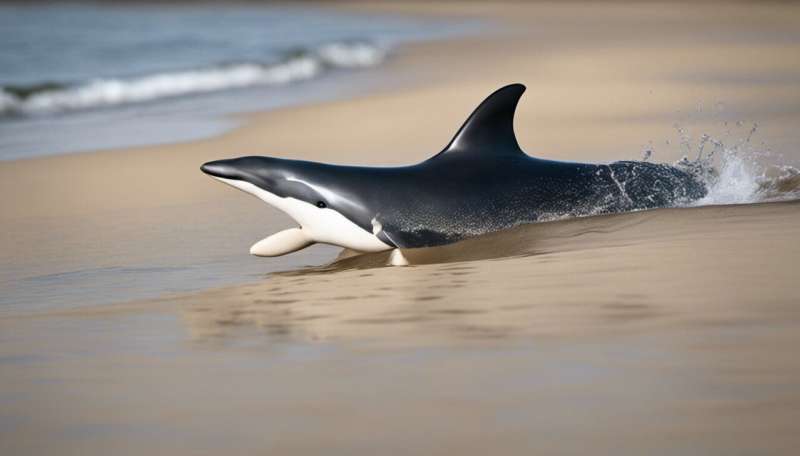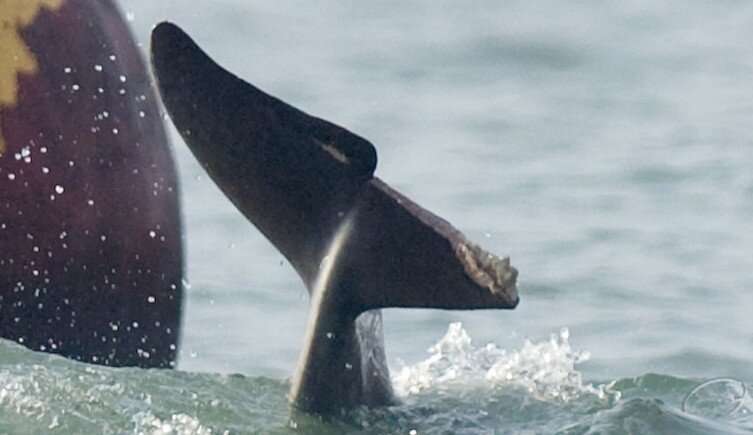What should I do if I encounter a solitary sociable cetacean?

Increasing numbers of whales and dolphins appear to be taking up solitary lives around the world.
Scientists and conservationists are continuing to investigate why this is happening, with the exact reasons remaining unclear.
Members of the public are being warned to keep their distance from lone whales and dolphins that take up residence along the coast.
Known as solitary sociable cetaceans (SSCs), these animals inhabit localized areas and have limited interactions with their own species, instead turning their attentions to humans. Bottlenose dolphins are the most common SSCs, but other species including beluga whales have also been known to take up residence in areas of human activity.
While these individuals may socialize with humans, they remain wild animals, and attempts to interact with them are dangerous to the cetaceans as well as ourselves.
Liz Sandeman is the co-founder of the charity Marine Connection, and has monitored SSCs for over 25 years. She says, "Watching wild whales and dolphins can be very exciting, but we have to keep our distance."
"Not only do we risk broken bones—or worse—by getting close to them, but it can also lead to the animal itself losing its wariness around us. This puts it at a much greater risk of being injured or killed by vessels, and several individuals have been lost recently because of this."
Anyone encountering a wild SSC is advised to keep their distance, and attempt to limit any interactions with the animal as much as possible.
Why do some whales and dolphins become solitary?
Solitary whales and dolphins are not, on the whole, unusual. Species such as the humpback whale can spend large portions of their lives alone, only coming together for feeding and mating.
Other individuals can at times become separated from their pods through storms, illness or other factors, and may end up in unsuitable environments such as rivers.
SSCs are set apart from these animals by their limited contact with others of their species, with the bulk of their interactions being as a result of encounters with humans and our equipment. They also tend to inhabit particular areas for an extended period of time, such as Fungie the dolphin who was known to have lived alone in Dingle harbor for more than 37 years.
From the 1980s until today, over 100 SSCs have been recorded around the world, though some accounts go much further back. The Roman writer Pliny the Elder recorded the stories of a number of possible SSCs, with a dolphin in what is now Bizerte, Libya said to regularly interact with humans.
While these animals have been known about for centuries, specific research has only begun in the past few decades. Many questions remain to be answered about these animals, including why they become solitary in the first place.
"It's unclear why these animals leave their pods," Liz says. "They may have been displaced from their natal group after becoming mature, or they may have left as a result of changing food availability. Other suggestions include the loss of a parent or mate, or differences in individual behavior."
It is also equally unclear why sightings of these animals appear to be becoming more common, which some have attributed to an increase in recordings.

Others, meanwhile, have suggested that the historic persecution of cetaceans, and ongoing threats, have increased the distance between pods. This means that individuals leaving or becoming separated from these groups have less chance of re-finding their pod or a new one, and so could become SSCs.
In any event, action is needed to protect these individuals from the impacts of human activity.
What threats do solitary sociable cetaceans face?
SSCs face many of the same threats that other cetaceans do, such as entanglements as well as chemical and noise pollution. However, they also face other dangers which are specific to their way of life.
"The biggest threat sociable solitary cetaceans face is habituation," Liz explains. "If these animals become too used to the presence of humans and vessels, they can be struck by ships."
"These ship strikes can be fatal or cause serious injuries that may cause the animal to suffer."
Humans can also harm the animals by interfering with their natural behavior. In 2008, two men were convicted of disturbing Dave the dolphin off the Kent coast after touching and grabbing the cetacean.
Getting too close to SSCs can also prove a risk to humans, with infrequent reports of people being hurt, or even killed, after provoking the animals.
Marine Connection, along with other organizations, aims to raise awareness of SSCs, and the risks associated with them, as part of its work. In 2021, they unveiled a memorial to Danny the dolphin, who was killed by a ship strike in the waters off Dorset.
The charity is also calling on the U.K. government to enact specific legislation to protect SSCs further, above and beyond the protections they already receive under more general cetacean legislation.
If you come across an SSC, do not attempt to approach it. Anyone deemed to be disturbing the cetacean may be guilty of an offense.
Individuals on the shoreline should not enter the water to try and get closer to the animal, but should instead watch it from a safe distance. They should also not feed the animal, as this could contribute to its habituation and could cause illness.
Richard Sabin, the Museum's Principal Curator of mammals, says, "Some cetacean species have a natural curiosity and will approach human divers in the wild at very close proximity. People need to remember that these are wild animals choosing to approach you on their terms."
"The desensitizing experience of seeing cetaceans in captivity projects an image of animals 'willing' to be handled and perform for our amusement, and emboldens people to take unnecessary risks with animals in the wild."
In addition, boat users are advised to stay more than 100 meters away from these animals where possible, and to avoid areas where they are known to rest and feed.
If an SSC approaches, then the vessel should be put into neutral until it leaves to prevent potential injuries. Any sudden movements of the boat should also be limited to ensure that the risk of a collision is kept to a minimum.
Provided by Natural History Museum




















